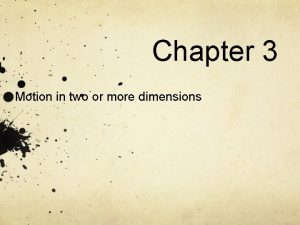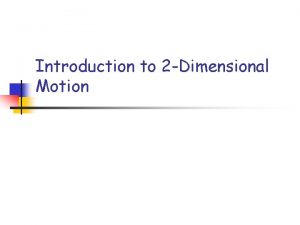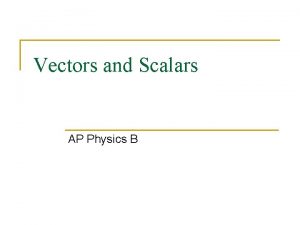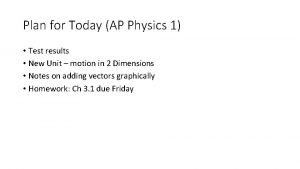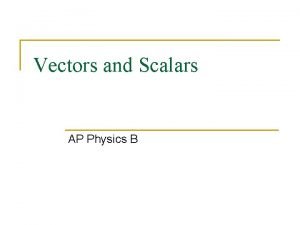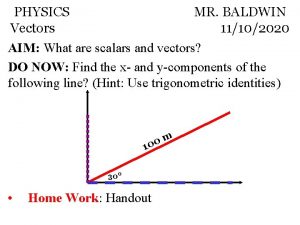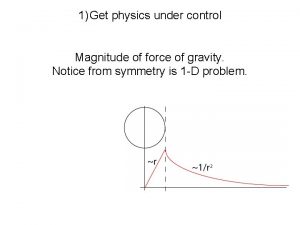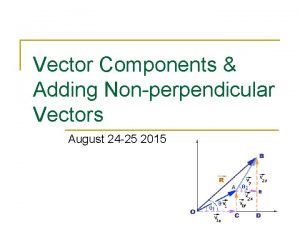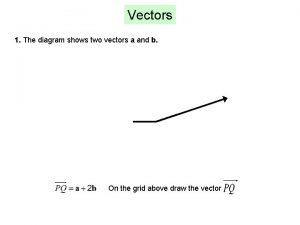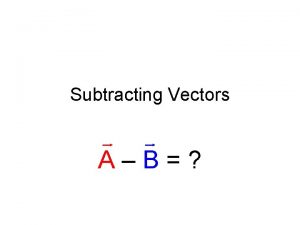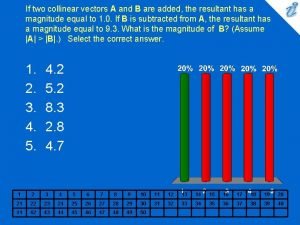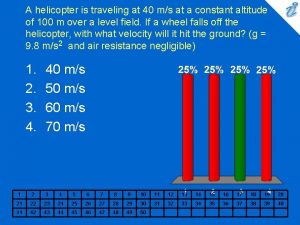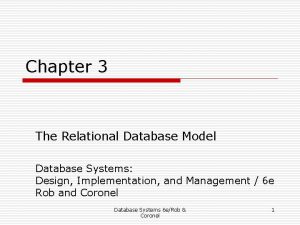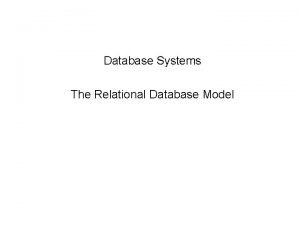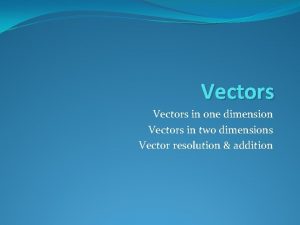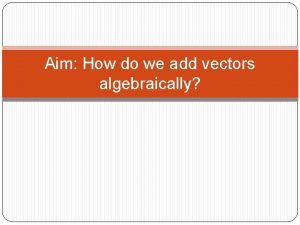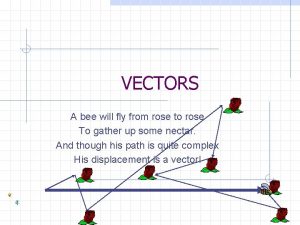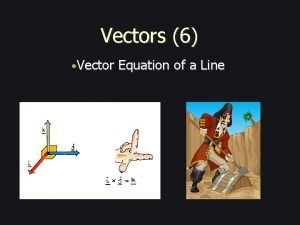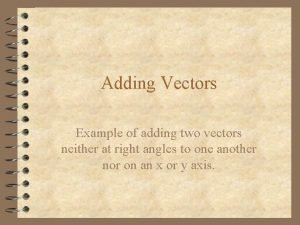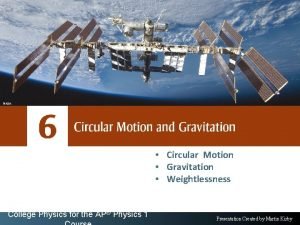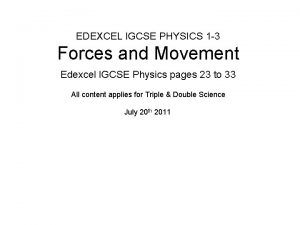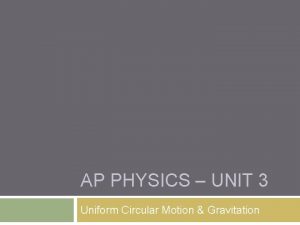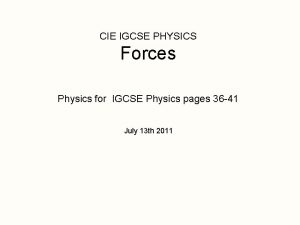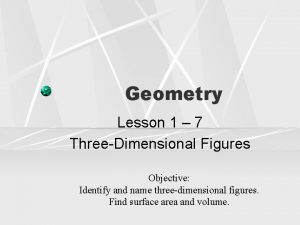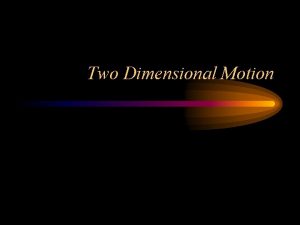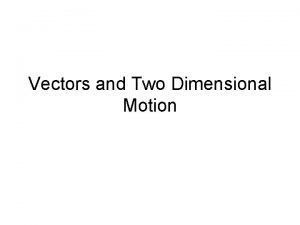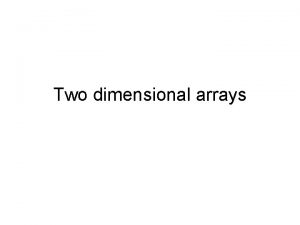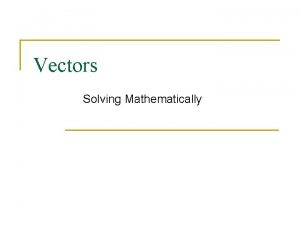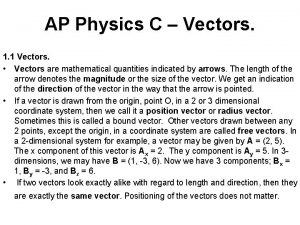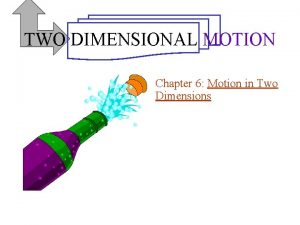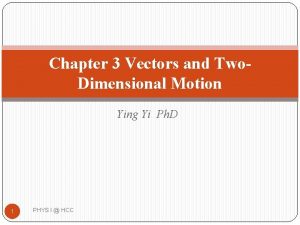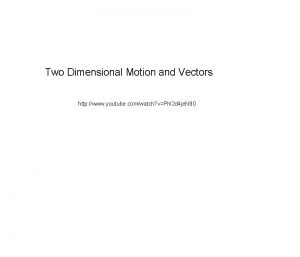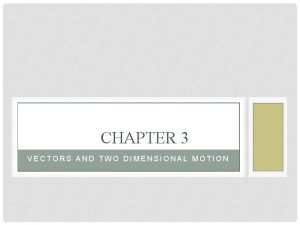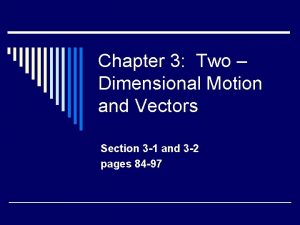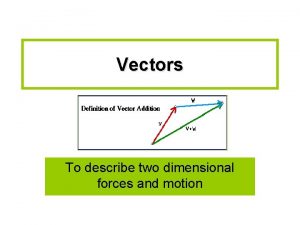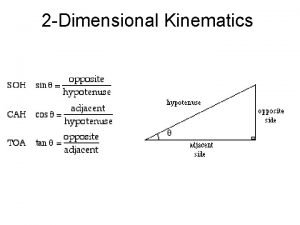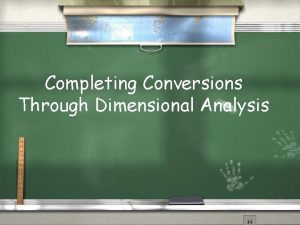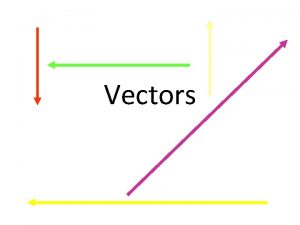Physics Lesson 5 Two Dimensional Motion and Vectors

































- Slides: 33

Physics Lesson 5 Two Dimensional Motion and Vectors Eleanor Roosevelt High School Mr. Chin-Sung Lin

Two Dimensional Motion and Vectors Scalars & Vectors Vector Representation One-Dimensional Vector Addition Two-Dimensional Vector Addition Vector Resolution Vector Addition Through Resolution Vector Application: Relative Velocity

Scalars & Vectors

Scalars & Vectors Comparison of Scalars & Vectors Physical Quantities Scalars Vectors Magnitude Direction

Scalars & Vectors Comparison of Scalars & Vectors Physical Quantities Scalars Magnitude Vectors 3 m/s Magnitude 60 o Direction

Scalars & Vectors Examples of Scalars & Vectors Physical Quantities Scalars Vectors distance displacement speed velocity acceleration mass force

Vector Representation

Vector Representation Arrows An arrow is used to represent the magnitude and direction of a vector quantity Magnitude: the length of the arrow Direction: the direction of the arrow e ud t i n g Ma Head Direction Tail

Vector Representation Equality of Vectors are equal when they have the same magnitude and direction, irrespective of their point of origin e Ma ud t i n g Direction

Vector Representation Negative Vectors A vector having the same magnitude but opposite direction to a vector -A A

One-Dimensional Vector Addition

One-Dimensional Vector Addition (Same Direction) The result of adding two vectors (resultant) with the same direction is the sum of the two magnitudes and the same direction 5 m 5 m 10 m

One-Dimensional Vector Addition (Opposite Directions) The result of adding two vectors (resultant) with opposite directions is the difference of the two magnitudes and the direction of the longer one 10 m -5 m 5 m

Two-Dimensional Vector Addition

Two-Dimensional Vector Addition (Parallelogram Method) The resultant is the diagonal of the parallelogram described by the two vectors B t n a t l u es R A

Two-Dimensional Vector Addition (Head-Tail Method) Many vectors can be added together by drawing the successive vectors in a head-to-tail fashion. The resultant is from the tail of the first vector to the head of the last vector A B t R n a t l u es

Two-Dimensional Vector Addition Vector Subtraction One vector subtracts another vector is the same as one vector adds another negative vector A – B = A + (-B) A B

Two-Dimensional Vector Addition Vector Subtraction One vector subtracts another vector is the same as one vector adds another negative vector A – B = A + (-B) A -B Re su lta nt

Vector Resolution

Vector Resolution Component Vectors Any vector can be resolved into two component vectors (vertical and horizontal components) at right angle to each other Vertical component or t c Ve Horizontal component

Vector Resolution Component Vectors The process of determining the components of a vector is called vector resolution Vertical component or t c Ve Horizontal component

Vector Resolution Calculate Component Vectors The magnitude of the horizontal component vx = v cos θ The magnitude of the vertical component vy = v sin θ Vy = V sin θ Vx = V cos θ

Two-dimensional vector addition through vector resolution

Vector Addition through Resolution Two-Dimensional Vectors Addition Resolve vectors into horizontal and vertical components Add all the horizontal components of the vectors Add all the vertical components of the vectors. Find the final resultant by adding the horizontal and vertical components of the final resultant

Vector Addition through Resolution Two-Dimensional Vectors Addition Ay Bx Rx Ry By B A Ax R

Vector Addition through Resolution Two-Dimensional Vectors Addition o) o)= 40. 0 20. 0 -30. 0 m/scos – 2 cos 26. 0 (30 (60 m/s =34. 6 =-15. 0 -6. 0 m/s m/s 2) sqrt (19. 6 + 6. 0 m/s = 20. 5 m/s om/s 34. 6 -30. 0 40. 0 m/ssin –sin 15. 0 (30 (60 )o)==20. 0 = -26. 0 19. 6 m/s o tan-1 m/s (-6. 0 m/s /19. 6 m/s) =m/s -16. 9 20. 0 m/s -15. 0 m/s 60 o -6. 0 m/s s / m 0. 40 34. 6 m/s 30 o 19. 6 m/s -16. 9 o -26. 0 m/s 30. 0 m/s 20. 5 m/s

Vector Application: Relative Motion

Vector Application Relative Velocity Relative velocity is the vector difference between the velocities of two objects in the same coordinate system

Vector Application Relative Velocity For example, if the velocities of particles A and B are v. A and v. B respectively in the same coordinate system, then the relative velocity of A with respect to B (also called the velocity of A relative to B) is v. A – v. B VA VA – V B VB

Vector Application Relative Velocity The relative velocity vector calculation for both one- and two-dimensional motion are similar The velocity vector subtraction (v. A – v. B ) can be viewed as vector addition (v. A + (–v. B)) VA VA +(–VB) -VB

Vector Application Relative Velocity Conversely the velocity of B relative to A is v. B – v. A VA VB – V A VB

Q&A

The End
 Sin 37
Sin 37 A circular motion is one dimensional
A circular motion is one dimensional Two dimensional motion
Two dimensional motion Two dimensional motion definition
Two dimensional motion definition A storm system moves 5000 km due east
A storm system moves 5000 km due east Lesson 4 gravity and motion lesson review
Lesson 4 gravity and motion lesson review Carl yaztremski
Carl yaztremski Ap physics vectors test
Ap physics vectors test A storm system moves 5000 km due east
A storm system moves 5000 km due east Graphical addition of vectors
Graphical addition of vectors Physics vectors
Physics vectors A bear searching for food wanders 35 meters east
A bear searching for food wanders 35 meters east Adding non perpendicular vectors
Adding non perpendicular vectors Vectors form 3
Vectors form 3 The diagram shows two vectors x and y
The diagram shows two vectors x and y The diagram shows two vectors that point west and north.
The diagram shows two vectors that point west and north. Collinear vector
Collinear vector A student adds two vectors with magnitudes of 200 and 40
A student adds two vectors with magnitudes of 200 and 40 1 dimensional figures
1 dimensional figures Two-dimensional structure composed of rows and columns
Two-dimensional structure composed of rows and columns Two-dimensional structure composed of rows and columns
Two-dimensional structure composed of rows and columns The direction of the resultant of unlike parallel forces is
The direction of the resultant of unlike parallel forces is Inner product example
Inner product example Vectors in one dimension
Vectors in one dimension How to add vectors algebraically
How to add vectors algebraically Unit vector notation
Unit vector notation Vector formula
Vector formula Cross product of two vectors
Cross product of two vectors Adding two vectors
Adding two vectors Circular motion images
Circular motion images Forces on a car
Forces on a car Unit 3 circular motion and gravitation
Unit 3 circular motion and gravitation Igcse physics forces and motion
Igcse physics forces and motion 1-7 three dimensional figures
1-7 three dimensional figures


